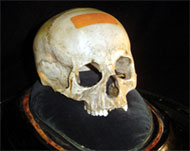CSI Mozart draws a blank
Forensic scientists have been unable to say if a skull kept in Wolfgang Amadeus Mozart’s home town of Salzburg is that of the composer born 250 years ago.

Austrian public TV station ORF commissioned an international research project last year to analyse teeth extracted from the skull. The project was dubbed CSI Mozart, after the US television dramas about crime scene investigators.
ORF told the scientists to apply methods such as genetic testing to determine the identity of the skull, which the Mozarteum foundation in Salzburg obtained in 1902.
But the scientists – from the University of Innsbruck and the US Armed Forces DNA Identification Laboratory in Rockville, Maryland – drew a blank, ORF said in its documentary broadcast on Sunday night.
They compared the skull’s DNA with genetic information retrieved from a grave where Mozart’s niece and his grandmother were believed to have been buried.
But they found that neither of the two female skeletons was related, nor was either of them related to the person whose skull rests in the Mozarteum’s safe.
Walther Parson, of Innsbruck University, said: “The identity of the individuals concerned in the Mozart family grave has proven to be a mystery.”
History
So the skull’s secret, which began more than 200 years ago, remains unsolved.
 |
|
The skull was taken off display |
Joseph Rothmayer, a gravedigger who buried Mozart in a pauper’s grave in Vienna’s Central Cemetery in 1791, claimed to have unearthed the skull 10 years later. It ended up at the Mozarteum a century after that.
The foundation put the skull on display until 1940 when its exhibition was deemed indecent and the relic went into a safe and was made available only to scientists. Many argued that the skull belonged to Mozart, while others cast doubt on its authenticity.